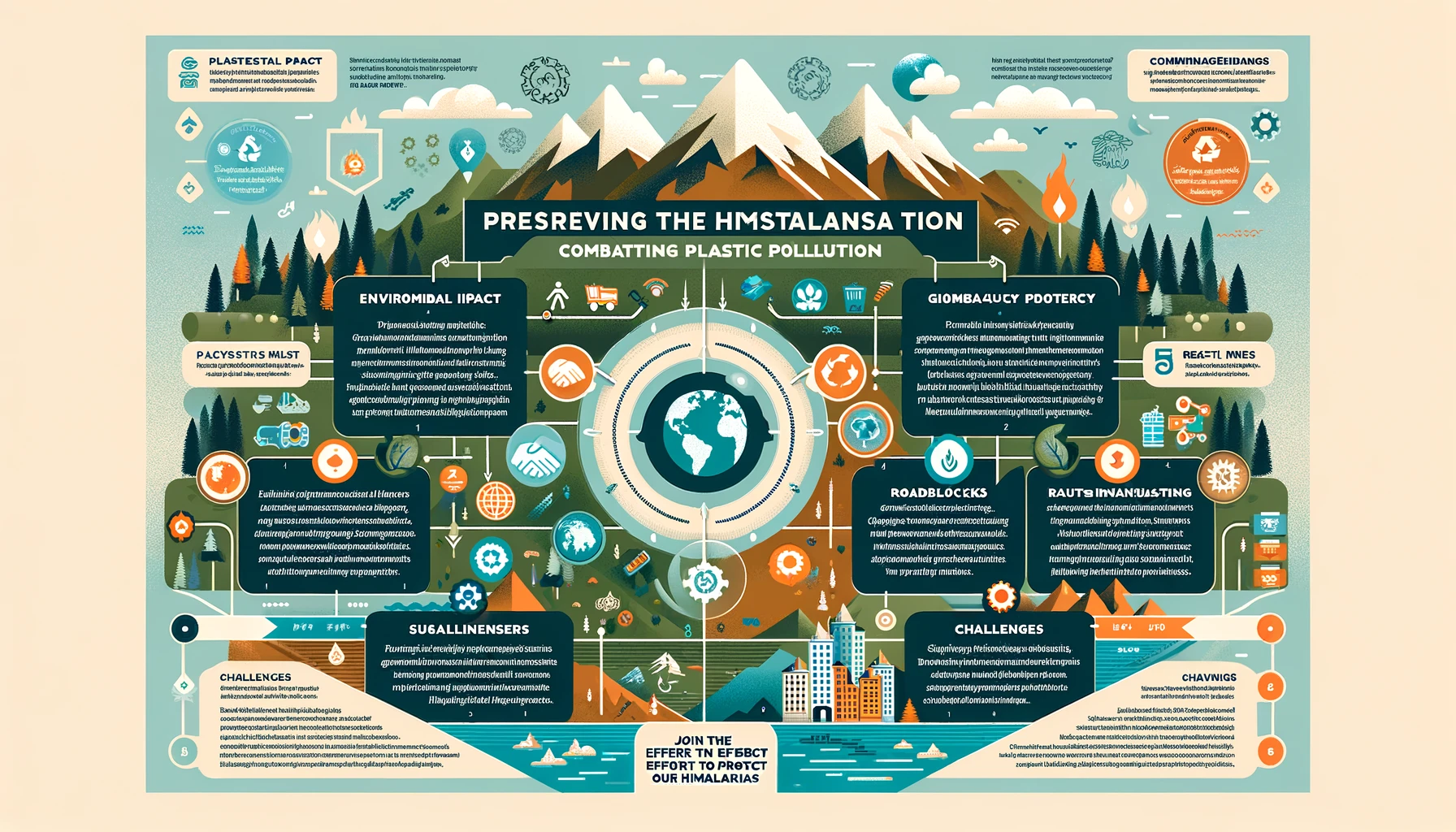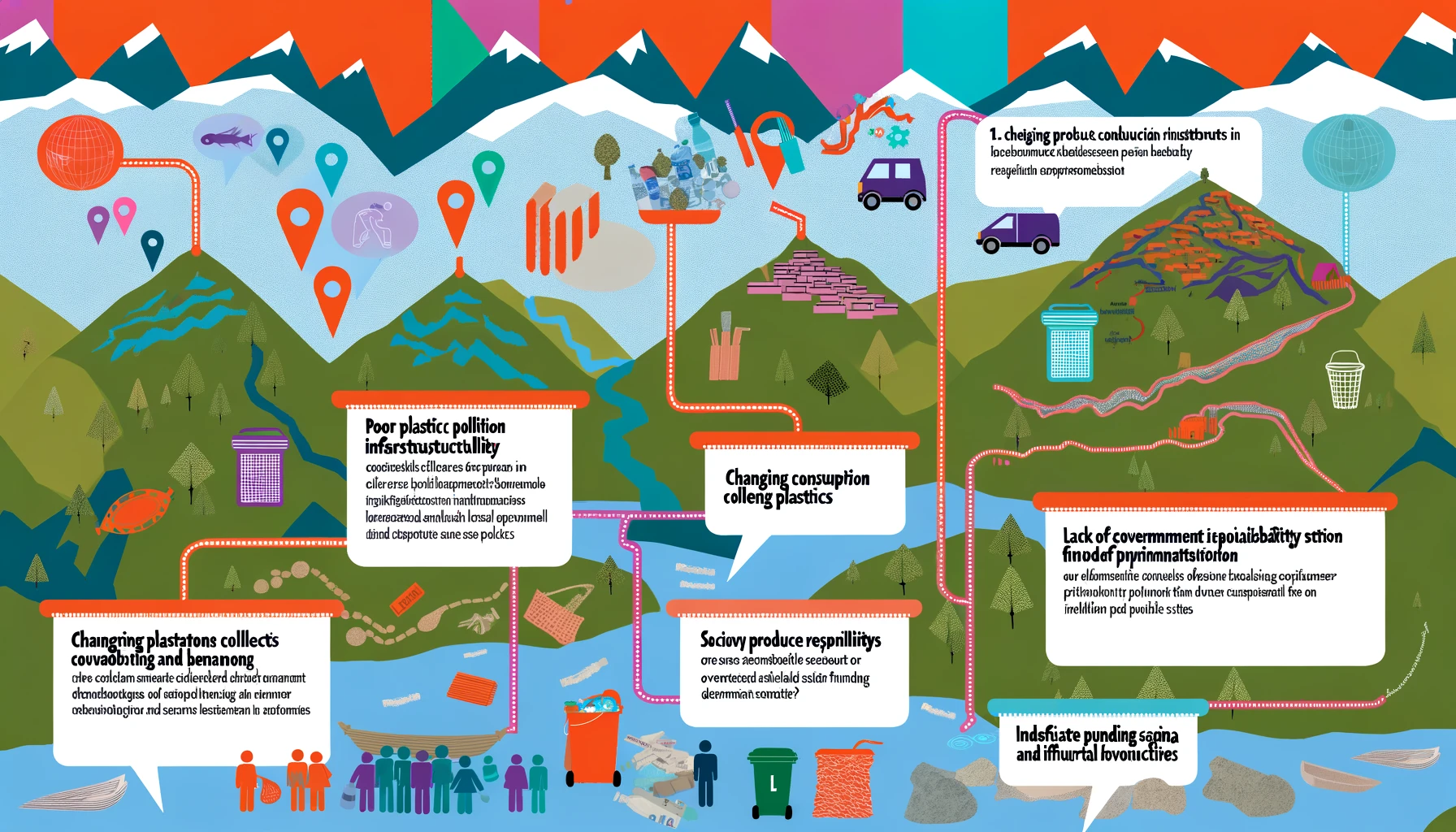
Plastic is literally everywhere nowadays, from towering mountain peaks to the depths of ocean trenches. It’s even been found inside human lungs and the placenta. Microplastics, the tiny particles formed from the breakdown of larger plastic items, are becoming a global concern. They’re turning up in places like the majestic Himalayan mountains, as well as in rivers, lakes, and streams.
The Indian Himalayan Region (IHR) is crucial for providing water to the Indian subcontinent. It’s the source of major rivers like the Indus, Ganges, and Brahmaputra. But unfortunately, improper disposal of plastic is causing serious pollution here. This pollution is not just harming the soil and water, but also the diverse wildlife that calls this region home. And it’s not just a local problem – downstream communities are feeling the effects too, as their freshwater sources become contaminated.
Plastic Pollution Crisis in the Indian Himalayan Region (IHR)
Report by SDC Foundation Dehradun
- SDC Foundation Dehradun’s recent report highlights the alarming plastic waste situation in Uttarakhand towns.
NGT Findings
- The National Green Tribunal (NGT) issued notices regarding waste dumping in eco-sensitive areas by tourists and commercial establishments.
- Ministry of Environment, Forest and Climate Change, Central Pollution Control Board (CPCB), and Himachal Pradesh State Pollution Control Board are involved.
Waste Dumping Concerns
- Tourists and commercial establishments are dumping waste without repercussions, exacerbating the issue.
Observations at Deepor Beel
- At Assam’s Ramsar site, Deepor Beel, Greater adjutant storks are consuming plastic waste instead of fish.
- Pollution in Manipur’s rivers, particularly the Nambul, is rising.
Audit Results of Himalayan Clean up
- The Himalayan Clean up (2018-21) conducted by Integrated Mountain Initiative, Zero Waste Himalayas, and National Productivity Council of India revealed escalating plastic waste, especially non-recyclables, in the Indian Himalayan Region.
- The 2022 audit found that 92.7% of waste was plastic, with 72% being non-recyclable.
Concerns Related to Plastic Waste Management in India
Very High Mismanaged Waste Index (MWI):
- India reached its plastic overshoot day on 6th January in 2023.
- The Mismanaged Waste Index (MWI) stands at 98.55%, one of the highest globally.
- This indicates a significant gap in waste management capacity compared to plastic consumption.
- Despite claims of a systemic ability to deal with plastic waste, the situation remains dire.
Abysmal Waste Recycling Rate:
- Government claims suggest a 60% recycling rate for plastic waste.
- However, statistical analysis by the Centre for Science and Environment (CSE) reveals a mere 12% recycling rate through mechanical means.
- Approximately 20% of plastic waste is burned for end-of-life solutions, falsely labeled as recycling.
- Nearly 68% of plastic waste remains unaccounted for, exacerbating the issue.
Lack of Recognition for the Needs of the Hills:
- Regulatory frameworks like Solid Waste Management Rules (SWM) 2016 and Plastic Waste Management (PWM) Rules 2016 fail to recognize the unique needs of hill areas.
- Special provisions for hill areas are absent in mandates for local bodies and Producers, Importers, and Brand Owners (PIBOs).
- The oversight in acknowledging these needs further complicates effective waste management in such regions.
Leachate From the Landfills:
- Despite theoretical waste segregation, landfills are overwhelmed with mixed waste.
- Leachate from these landfills contributes to soil and groundwater pollution, while fumes worsen air quality.
- Large quantities of recyclable plastic waste remain trapped in landfills, exacerbating environmental degradation.
Factors Contributing to Rising Plastic Pollution in the Indian Himalayan Region (IHR)

Poor Waste Collection Infrastructure:
- Lack of proper waste collection and infrastructure leads to more than 60% of waste being dumped, burned, or swept downstream into key rivers like the Ganga, Yamuna, and Sutlej.
- Uttarakhand and Himachal Pradesh, despite witnessing over 400 million tourists since 2010, have inadequate solid waste management systems.
Changing Consumption Patterns in Rural Areas:
- Rapid replacement of traditional materials with cheaper plastic products in rural areas due to the availability of Fast-Moving Consumer Goods (FMCGs) in multilayered plastic packaging.
- Tourists visiting conservation areas like the Govind Wildlife Sanctuary in Uttarkashi generate significant amounts of plastic waste, contributing to the problem.
Heavy Influx of Tourists and Single-Use Products:
- Increasing tourist activity in the Himalayan states influences local consumption patterns, leading to widespread littering, dumping, and burning of waste.
- Lack of proper waste management infrastructure in remote tourist areas exacerbates the problem.
Difficult Terrain for Logistics:
- The challenging Himalayan terrain increases operational costs, complicates transportation logistics, and widens the distance from recycling facilities.
- Lack of dry and wet waste processing facilities further exacerbates the issue.
Lack of Reach of Extended Producer Responsibility (EPR):
- FMCG brands mandated to support plastic waste management under the Plastic Waste Management Rules 2016 often neglect reverse logistics in hilly areas due to high collection costs.
- Local brands lack the capacity to invest in reverse logistics, leading to uncollected waste, especially from tourist-generated consumption.
Lack of Policy Enforcement and Convergence:
- Sporadic waste collection and dumping occur due to inadequate policy enforcement and collaboration among government departments.
- Informal waste pickers play a significant role in material recovery but are limited to urban and tourist areas.
Ineffective Collaboration Among Government Departments:
- Lack of coordination among government departments hampers the efficient use of funds allocated for waste management initiatives.
- Uncertainty about operational management of waste management units further complicates the situation.
Social Stigma and Informal Livelihoods:
- Social stigma attached to waste-related livelihoods discourages local involvement in waste management activities.
- Unlike urban areas, rural areas lack informal migrant workers for waste collection and segregation.
Inadequate Funding Capacity:
- Insufficient funding provided to gram panchayats under the Swachh Bharat Mission-Gramin guidelines for hilly areas due to lower population density and difficult terrain compared to plains villages.
Mitigating the Crisis in IHR: Steps to Address Waste Management
Ensuring Sufficient Investments:
- Recognize the need for substantial investments to tackle waste management issues in the Indian Himalayan Region (IHR).
- Highlight the disparity between current efforts and the scale of the problem.
- Emphasize the necessity for global investment akin to ocean plastic pollution initiatives.
Coordination With Rural Residents:
- Engage gram panchayats, village development officers, and national entities like the National Rural Livelihoods Mission.
- Collaborate with rural residents to combat waste pollution and create livelihood opportunities in waste management.
World Bank Study With KGGTF:
- Discuss the collaborative effort between the World Bank and the Korean Green Growth Trust Fund (KGGTF) to assess plastic waste management in India, Nepal, and Pakistan’s mountainous regions.
- Highlight the recommendation for a systematic, phased approach to improve waste management services.
Need For Adopting State Specific Initiatives:
- Highlight state-specific initiatives, such as Himachal Pradesh and Sikkim’s laws banning plastics, and Mizoram’s regulatory measures.
- Stress the importance of adopting successful initiatives across all states in the IHR.
Segregating Different Types of Plastics:
- Emphasize the necessity of waste segregation at the source, including different types of plastics.
- Stress the importance of sustained public education campaigns to encourage participation in waste segregation.
Devolving Powers to Local Bodies:
- Discuss the role of local bodies in waste management and the need for empowerment.
- Highlight the potential value of Extended Producer Responsibility (EPR) certificates for local bodies.
Including Traditional Institutions:
- Advocate for the inclusion of traditional institutions in waste management efforts.
- Note the allocation of funds to traditional institutions under schemes like the Swachh Bharat Mission.
Integrating Rich Biodiversity With Waste Management:
- Stress the importance of considering the ecological sensitivity and biodiversity of the IHR in waste management strategies.
- Discuss the need for appropriate resource allocation and support.
Plugging Data Gaps:
- Address the need to fill data gaps concerning waste generation in the IHR.
- Suggest using existing schemes like the Swachh Bharat Mission and the Mahatma Gandhi National Rural Employment Guarantee Act to improve infrastructure.
Augmenting Resources on Expedited Basis:
- Discuss avenues like the Swachh Bharat Kosh Trust and corporate social responsibility funds for resource augmentation.
- Advocate for convergence between schemes like AMRUT and Smart Cities to address waste management in the IHR.
Conclusion
The widespread presence of plastic, from lofty mountain peaks to the deepest ocean depths, and even within the human body, highlights the immediate need for action. Incorrect disposal results in the creation of tiny plastic particles known as microplastics, now discovered in the Himalayas, rivers, lakes, and streams across the Indian subcontinent. There is an urgent requirement for improved data gathering and allocation of resources, particularly in the environmentally fragile Himalayan region. Public awareness and community involvement are paramount for effective waste sorting and management. Collaboration between local authorities and manufacturers is indispensable, with the possibility of issuing higher-value Extended Producer Responsibility (EPR) certificates in mountainous areas.

